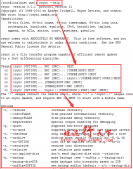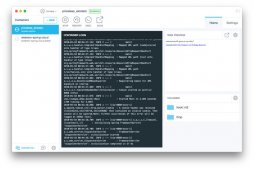前言
使用rabbitmq的時候,當(dāng)你客戶端與rabbitmq服務(wù)器之間一段時間沒有流量,服務(wù)器將會斷開與客戶端之間tcp連接。
而你將在服務(wù)器上看這樣的日志:
missed heartbeats from client, timeout: xxs
這個間隔時間就是心跳間隔。
heartbeat通常用來檢測通信的對端是否存活(未正常關(guān)閉socket連接而異常crash)。其基本原理是檢測對應(yīng)的socket連接上數(shù)據(jù)的收發(fā)是否正常,如果一段時間內(nèi)沒有收發(fā)數(shù)據(jù),則向?qū)Χ税l(fā)送一個心跳檢測包,如果一段時間內(nèi)沒有回應(yīng)則認(rèn)為心跳超時,即認(rèn)為對端可能異常crash了。
rabbitmq也不例外,heatbeat在客戶端和服務(wù)端之間用于檢測對端是否正常,即客戶端與服務(wù)端之間的tcp鏈接是否正常。
關(guān)于rabbitmq心跳
1.heartbeat檢測時間間隔可在配置文件rabbitmq.config中增加配置項{heartbeat,Timeout}進(jìn)行配置,其中Timeout指定時間間隔,單位為秒,另外客戶端也可以配置heartbeat時間。
如果服務(wù)端沒有配置
默認(rèn)代理心跳時間:
RabbitMQ 3.2.2:580秒
RabbitMQ 3.5.5:60秒
2.官方建議不要禁用心跳,且建議心跳時間為60秒。
3.心跳每 heartbeat timeout / 2 秒發(fā)送一次,服務(wù)器兩次沒有接收到則斷開tcp連接,以前的連接將失效,客戶端需要重新連接。
4.如果你使用Java, .NET and Erlang clients,服務(wù)器與客戶端會協(xié)商heartbeat時間
如果其中一個值為0,則使用兩者中較大的一個
否則,使用兩者中較小的一個
兩個值都為0,則表示要禁用心跳,則服務(wù)端與客戶端維持此tcp連接,不會斷開。
注意:在python客戶端上直接設(shè)置為0,則禁用心跳。
禁用心跳在python客戶端該如何設(shè)置:
在py3:ConnectionParameters設(shè)置heartbeat_interval=0即可。
在py2:ConnectionParameters設(shè)置heartbeat=0即可。
5.連接上的任何流量(傳輸?shù)挠行?shù)據(jù)、確認(rèn)等)都將被計入有效心跳,當(dāng)然也包括心跳幀。
6.我在網(wǎng)上看到有人問到這個問題:
為什么服務(wù)端宕機(jī),在心跳檢測機(jī)制下,服務(wù)器側(cè)斷開連接,而客戶端這邊不能檢測到tcp斷開,我測試過,客戶端確實不能檢測到tcp連接斷開,只有當(dāng)客戶端在這個tcp有操作后,才能檢測到,當(dāng)然在一個斷開的tcp連接上做操作會報錯(如發(fā)送消息)。
|
1
2
3
4
5
6
7
8
9
10
11
12
13
14
15
16
17
18
19
|
import pika import time credit = pika.PlainCredentials(username='cloud', password='cloud')connection = pika.BlockingConnection(pika.ConnectionParameters( host='10.32.1.12', credentials=credit))channel = connection.channel() while True: connect_close = connection.is_closed connect_open = connection.is_open channel_close = channel.is_closed channel_open = channel.is_open print("connection is_closed ", connect_close) print("connection is_open ", connect_open) print("channel is_closed ", channel_close) print("channel is_open ", channel_open) print("") time.sleep(5) |
7.一些RabbitMQ客戶端(Bunny,Java,.NET,Objective-C,Swift)提供了一種在網(wǎng)絡(luò)故障后自動恢復(fù)連接的機(jī)制,而pika只能通過檢測連接異常后再重新創(chuàng)建連接的方式。
示例代碼:通過檢測連接異常,重新創(chuàng)建連接:
|
1
2
3
4
5
6
7
8
9
10
11
12
13
14
15
16
17
|
import pikawhile True: try: connection = pika.BlockingConnection() channel = connection.channel() channel.basic_consume('test', on_message_callback) channel.start_consuming() # Don't recover if connection was closed by broker except pika.exceptions.ConnectionClosedByBroker: break # Don't recover on channel errors except pika.exceptions.AMQPChannelError: break # Recover on all other connection errors except pika.exceptions.AMQPConnectionError: continue |
你也可以使用操作重試庫,例如 retry。
|
1
2
3
4
5
6
7
8
9
10
11
12
13
|
from retry import retry@retry(pika.exceptions.AMQPConnectionError, delay=5, jitter=(1, 3))def consume(): connection = pika.BlockingConnection() channel = connection.channel() channel.basic_consume('test', on_message_callback) try: channel.start_consuming() # Don't recover connections closed by server except pika.exceptions.ConnectionClosedByBroker: passconsume() |
heartbeat的實現(xiàn)
rabbitmq在收到來自客戶端的connection.tune-ok信令后,啟用心跳檢測,rabbitmq會為每個tcp連接創(chuàng)建兩個進(jìn)程用于心跳檢測,一個進(jìn)程定時檢測tcp連接上是否有數(shù)據(jù)發(fā)送(這里的發(fā)送是指rabbitmq發(fā)送數(shù)據(jù)給客戶端),如果一段時間內(nèi)沒有數(shù)據(jù)發(fā)送給客戶端,則發(fā)送一個心跳包給客戶端,然后循環(huán)進(jìn)行下一次檢測;另一個進(jìn)程定時檢測tcp連接上是否有數(shù)據(jù)的接收,如果一段時間內(nèi)沒有收到任何數(shù)據(jù),則判定為心跳超時,最終會關(guān)閉tcp連接。另外,rabbitmq的流量控制機(jī)制可能會暫停heartbeat檢測,這里不展開描述。
涉及的源碼:
|
1
2
3
4
5
6
7
8
9
10
11
12
13
14
15
16
17
18
19
20
21
22
23
24
25
26
27
28
29
30
31
32
33
34
35
36
37
38
39
40
41
42
43
44
45
46
47
48
49
50
51
52
53
54
55
56
57
58
59
|
start(SupPid, Sock, SendTimeoutSec, SendFun, ReceiveTimeoutSec, ReceiveFun) -> %%數(shù)據(jù)發(fā)送檢測進(jìn)程 {ok, Sender} = start_heartbeater(SendTimeoutSec, SupPid, Sock, SendFun, heartbeat_sender, start_heartbeat_sender), %%數(shù)據(jù)接收檢測進(jìn)程 {ok, Receiver} = start_heartbeater(ReceiveTimeoutSec, SupPid, Sock, ReceiveFun, heartbeat_receiver, start_heartbeat_receiver), {Sender, Receiver}.start_heartbeat_sender(Sock, TimeoutSec, SendFun) -> %% the 'div 2' is there so that we don't end up waiting for %% nearly 2 * TimeoutSec before sending a heartbeat in the %% boundary case heartbeater({Sock, TimeoutSec * 1000 div 2, send_oct, 0, fun () -> SendFun(), continue end}).start_heartbeat_receiver(Sock, TimeoutSec, ReceiveFun) -> %% we check for incoming data every interval, and time out after %% two checks with no change. As a result we will time out %% between 2 and 3 intervals after the last data has been %% received heartbeater({Sock, TimeoutSec * 1000, recv_oct, 1, fun () -> ReceiveFun(), stop end}).heartbeater({Sock, TimeoutMillisec, StatName, Threshold, Handler} = Params, Deb, {StatVal, SameCount} = State) -> Recurse = fun (State1) -> heartbeater(Params, Deb, State1) end, receive ... %% 定時檢測 after TimeoutMillisec -> case rabbit_net:getstat(Sock, [StatName]) of {ok, [{StatName, NewStatVal}]} -> %% 收發(fā)數(shù)據(jù)有變化 if NewStatVal =/= StatVal -> %%重新開始檢測 Recurse({NewStatVal, 0}); %%未達(dá)到指定次數(shù), 發(fā)送為0, 接收為1 SameCount < Threshold -> %%計數(shù)加1, 再次檢測 Recurse({NewStatVal, SameCount + 1}); %%heartbeat超時 true -> %%對于發(fā)送檢測超時, 向客戶端發(fā)送heartbeat包 %%對于接收檢測超時, 向父進(jìn)程發(fā)送超時通知 %%由父進(jìn)程觸發(fā)tcp關(guān)閉等操作 case Handler() of %%接收檢測超時 stop -> ok; %%發(fā)送檢測超時 continue -> Recurse({NewStatVal, 0}) end; ... |
收發(fā)檢測的時候利用了inet模塊的getstat,查看socket的統(tǒng)計信息
recv_oct: 查看socket上接收的字節(jié)數(shù)
send_oct: 查看socket上發(fā)送的字節(jié)數(shù)
inet詳細(xì)見這里: http://www.erlang.org/doc/man/inet.html
以上就是本文的全部內(nèi)容,希望對大家的學(xué)習(xí)有所幫助,也希望大家多多支持服務(wù)器之家。
原文鏈接:https://www.cnblogs.com/-wenli/p/13603712.html















